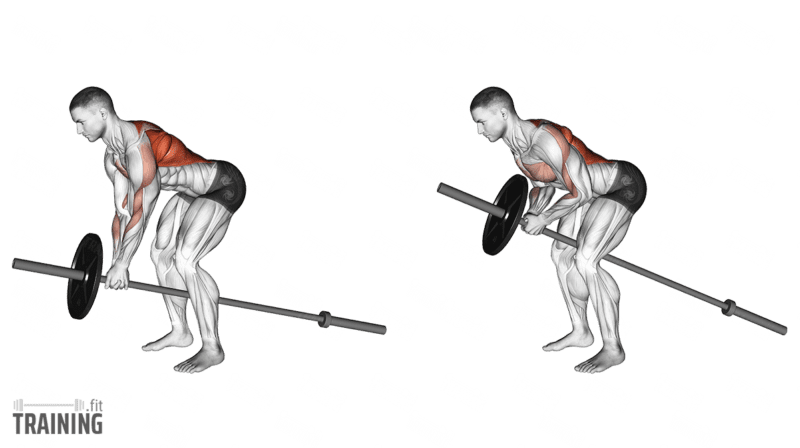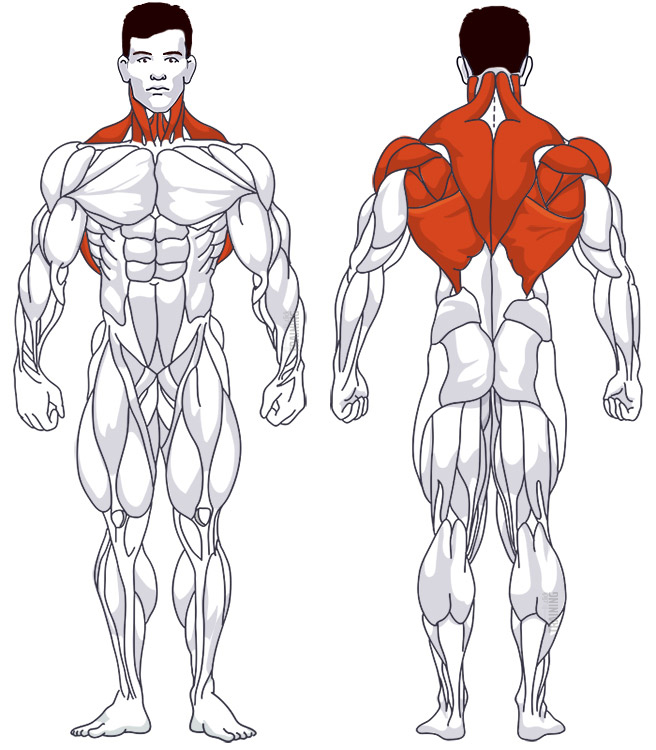T-Bar Row
Compound exercise, Free weightsOverview

Main muscles
- Neck: Trapezius muscle
(Musculus trapezius) - Back: Large round muscle
(Musculus teres major) - Back: Large back muscle
(Musculus latissimus dorsi) - Back: Larger rhomboid muscle
(Musculus rhomboideus major) - Back: Small round muscle
(Musculus teres minor) - Back: Lower back muscle
(Musculus infraspinatus) - Shoulder: Posterior deltoid muscle
(Musculus deltoideus, posterior deltoid muscle)
T-Bar Row: Basics and alternatives

Involved main muscle groups:
T-Bar Row
The T-Bar Row is an exercise that targets the upper back, neck, and rear shoulder. It’s similar to the barbell row, where you bend over and lift the weight upward.
The biggest difference between the T-Bar Row and the classic barbell row is the grip. In the T-Bar Row, you typically use a narrow neutral grip, which places more emphasis on your lat muscles and less on your neck and shoulders.
In addition to the barbell row, you can also target your upper back by trying rowing on the machine, cable pulldown, or reverse rowing.
Correct Execution
You can perform the T-Bar Row with or without an additional grip. If you use an angled cable grip under the barbell, the weight can usually be moved more safely. If no grip is available, you can also grip the bar firmly with both hands.
The grip you use is a matter of personal preference, but a narrow neutral grip is typically used in the T-Bar Row, as wider grips can be covered well with normal barbell rows.
A good tip to maximize your range of motion is to use smaller weight plates (check out the video). By using several small plates instead of a few large ones, you can bring the bar closer, increasing the range of motion and muscle stimulation.
The T-Bar Row is best performed with a T-Bar row platform. In the platform, the bar is placed and can only be rotated and lifted, not moved. If you don’t have the platform, you can place the barbell in a corner (e.g. of the power rack) and secure it with a heavy weight plate. This will work well, but may take a few tries to make sure the bar is secure.
Video tutorial
Step-by-Step Guide
Stand with your feet on either side of the barbell, which should already be positioned. The barbell should be between your legs, and you should be facing the weight plates.
Place the handle behind the weight plates by threading it through the center of the bar.
Bend your knees slightly and keep your back straight, with a slight arch. Stick your butt out and grip the handle tightly.
Tense your abs and pull your shoulder blades back a little. You’re now in the starting position.
Without swinging, lift the barbell towards your upper body by pulling on the handle. The movement is complete when the weight plate is just in front of your chest. Hold this position for a few seconds, then lower the weight back to the starting position slowly.
Avoid These Mistakes
Just like in barbell rows, keeping your back rounded is a big no-no in T-Bar Rows. Always keep your back straight. Bending your back puts a lot of stress on your discs and can lead to injury. To avoid unintended bending, stick your butt out and give it a slight “duck butt” look.